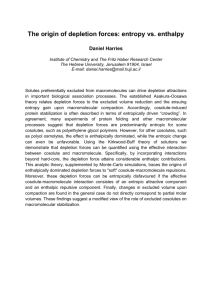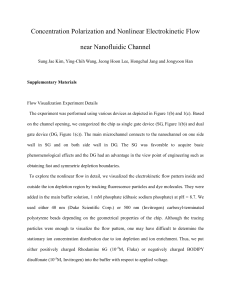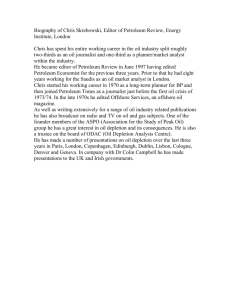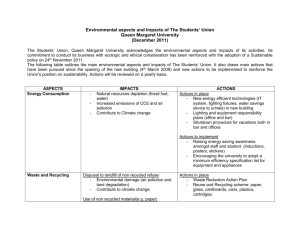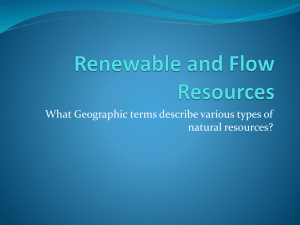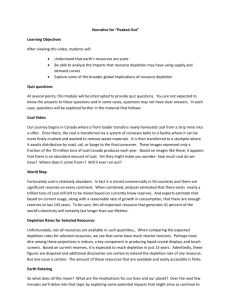Yes - The Association for the Study of Peak Oil and Gas
advertisement
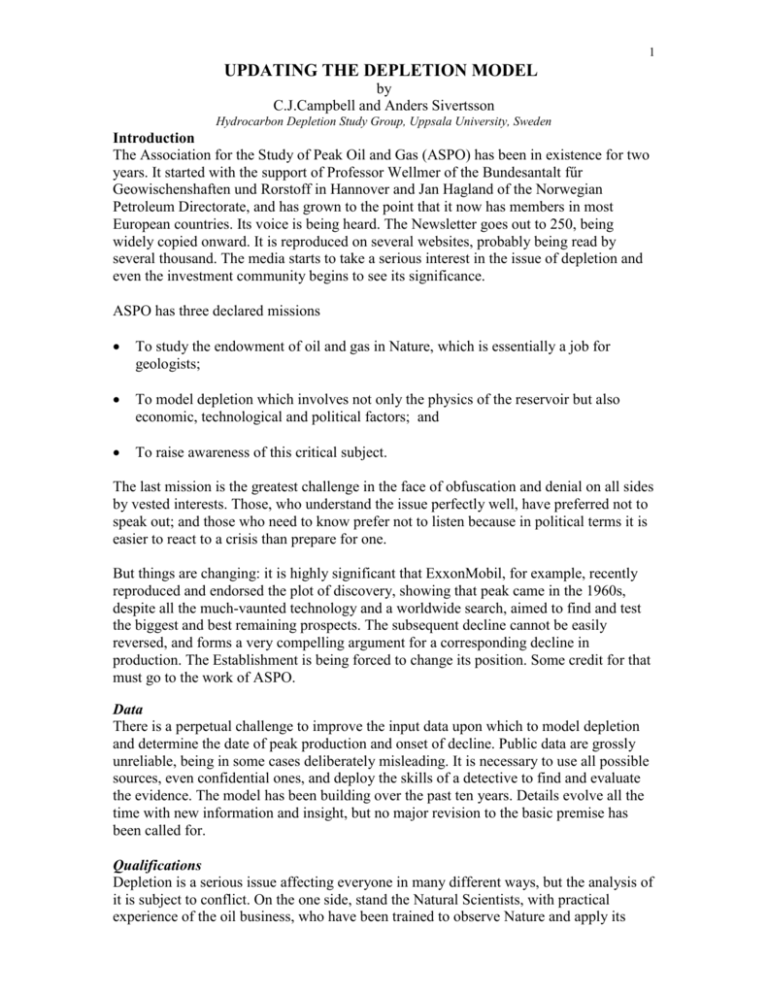
1 UPDATING THE DEPLETION MODEL by C.J.Campbell and Anders Sivertsson Hydrocarbon Depletion Study Group, Uppsala University, Sweden Introduction The Association for the Study of Peak Oil and Gas (ASPO) has been in existence for two years. It started with the support of Professor Wellmer of the Bundesantalt fűr Geowischenshaften und Rorstoff in Hannover and Jan Hagland of the Norwegian Petroleum Directorate, and has grown to the point that it now has members in most European countries. Its voice is being heard. The Newsletter goes out to 250, being widely copied onward. It is reproduced on several websites, probably being read by several thousand. The media starts to take a serious interest in the issue of depletion and even the investment community begins to see its significance. ASPO has three declared missions To study the endowment of oil and gas in Nature, which is essentially a job for geologists; To model depletion which involves not only the physics of the reservoir but also economic, technological and political factors; and To raise awareness of this critical subject. The last mission is the greatest challenge in the face of obfuscation and denial on all sides by vested interests. Those, who understand the issue perfectly well, have preferred not to speak out; and those who need to know prefer not to listen because in political terms it is easier to react to a crisis than prepare for one. But things are changing: it is highly significant that ExxonMobil, for example, recently reproduced and endorsed the plot of discovery, showing that peak came in the 1960s, despite all the much-vaunted technology and a worldwide search, aimed to find and test the biggest and best remaining prospects. The subsequent decline cannot be easily reversed, and forms a very compelling argument for a corresponding decline in production. The Establishment is being forced to change its position. Some credit for that must go to the work of ASPO. Data There is a perpetual challenge to improve the input data upon which to model depletion and determine the date of peak production and onset of decline. Public data are grossly unreliable, being in some cases deliberately misleading. It is necessary to use all possible sources, even confidential ones, and deploy the skills of a detective to find and evaluate the evidence. The model has been building over the past ten years. Details evolve all the time with new information and insight, but no major revision to the basic premise has been called for. Qualifications Depletion is a serious issue affecting everyone in many different ways, but the analysis of it is subject to conflict. On the one side, stand the Natural Scientists, with practical experience of the oil business, who have been trained to observe Nature and apply its 2 immutable physical laws; while on the other, lie the Classical Economists, who deny that resource constraints can arise in an open market. This paper springs from the former camp, based on the experiences of those who has searched the world for oil, drilling many dry holes in the process as well as making a few discoveries. That very relationship says much. The study has evolved in many ways over the years. Definitions have been modified with new understandings, and better statistical techniques have been applied. Some approaches have been tried and rejected when found deficient. To the scientist, this evolution speaks of progress, but detractors take it as evidence of fundamental flaws. It is worth recalling here that even the most famous Economist of them all, Meynard Keynes, replied to criticism of inconsistency with the immortal words: “When I get new information, I change my conclusions. What do you do, Sir?” Some Simple Questions There are three simple questions to ask: What has been found? How much has been found? When was it found? They sound simple, but they are hard to answer because of ambiguous definitions and lax reporting practices. If we could answer them, it would be a relatively easy matter to extrapolate the trends to show how much oil and gas are left to find and produce in the future. What has been found? It is important to recognise that there are many different types of oil and gas. Each has its own: Endowment in Nature Costs and characteristics Depletion profile It is better to divide than combine, even if the boundaries are fuzzy because of imprecise data. There is, clearly, a huge difference between a free-flowing well in the Middle East, producing 50 000 b/d, and digging up a tarsand in Canada with a shovel, even a big one. The terms Conventional and Unconventional are widely used but with standard definition of the boundary. So, to avoid confusion, it may be better to use another term such as Regular Oil and define it to exclude the following categories: Oil from coal and “shale: Bitumen and Extra Heavy Oil Heavy Oil ( <17.5o API) Polar Oil Deepwater Oil (>500m) Natural Gas Liquids from gasfields and plants Regular Oil, as so defined, has supplied most production to-date and will dominate all production far into the future. It will therefore control the peak of all production. Production is not quite the same as Supply, which takes into account refinery gains, stock changes, war-loss, and in some cases operating fuel and re-injected gas. 3 Non-Regular Oils are important too but have different depletion profiles. It is important to recognise them all, even if in practice accurate boundaries cannot be drawn on the data available. Gas-liquids are particularly tricky. There can be phase changes in the reservoir as well as when the oil and gas are brought to the surface. In practice, Condensate that condenses naturally on being brought to the surface from the gas-caps of oilfields can be treated together with the oil, with which it is commonly metered. On the other hand, the liquids, condensing from gasfields or produced in gas plants, need to be distinguished, because they will deplete in relation to the gas, not oil. There are grey areas of detail but the totals are believed to be reasonable in terms of order of magnitude. How much has been found? Answering the second question of how much has been found faces again confusing definitions. It comprises the amounts produced to the reference date in known fields plus estimates of what left to produce from them. The term Proved Reserves is widely used for financial reporting purposes. In plain language, it means Proved-so-Far by current wells or development plans, not necessarily saying much about the full size of the field as a whole. The term Reserves is used in many senses, meaning variously the amount expected to be produced before production began; the amount left at the reference date; and the amounts subject to various probability rankings or reporting practices. Some of these confusions can be avoided by ignoring the term altogether, and speaking instead only of Production as follows (with the classic terminology in parenthesis) -Past Production (Cumulative Production) -Estimated Future Production From known fields (Reserves) From new fields (Yet-to-Find, Undiscovered) - Total (Ultimate) In is convenient too to set a date cut-off of, say, 2075 to save having to worry about tailend production, which can drag on for a very long time, having a negligible impact on the calculation of peak - the prime interest under consideration. Obviously, all estimates are subject to uncertainty, or what is called Probability. Probability theory has its place in evaluating the technical reservoir parameters of an oilfield, but in general discussion of the issue may confuse more than clarify. It is a common procedure to describe the uncertainly under a subjective probability range whereby a prospect or area is said to have a 95% probability of finding more than the stated value and a 5% probability of finding a much higher amount. From this range, Mean, Mode and Median values may be calculated, with the Mean value being supposedly the best estimate. The procedure gives an appearance of scientific exactitude, but whether it actually improves the determination of the best estimate is open to doubt, as the High (5% Probability) Case which influences the calculations is based on very flimsy evidence. For example, the US Geological Survey states that a virtually unknown and un-drilled area in East Greenland has a 95% subjective probability of having more than zero, namely at least one barrel; and 5% probability of having more than 112 Gb (billion 4 barrels). A Mean value of 47 Gb has been calculated from this wide and uncertain range, and is incorporated in global estimates. The key word in all of this is subjective, which undermines the credibility of the derived statistics. While such an approach may appeal to the mathematically inclined, there is much to be said in pragmatic terms to aim at the bull’s eye, rather than worry about the probable width of the target. When was it found? From an exploration standpoint, an oilfield is found by the first successful borehole drilled into it, remembering especially that discovery is a transcendental event, accompanied by many failures. Less that one-in-ten Wildcat boreholes finds hydrocarbons, and the number is closer one-in-a-hundred to find any significant accumulation. The odds continue to lengthen as the inventory of viable prospects dwindles. Accordingly, in terms of discovery, all the oil ever produced from a field under whatever economic or technical conditions - is logically attributable to the date of the discovery borehole. For financial or economic purposes, there may be other ways of looking at it, but backdating is critical to determining a valid discovery trend in resource terms. Failure to backdate is probably the cause of more misunderstanding than any other single factor. Reserve revisions normally appear in the public database on the date they are announced. Analysts looking at such information in isolation can be excused for concluding that the growth of reserves shows little sign of slackening. Impact of Backdating Revisions 2500 Discovery Gb 2000 1500 1000 500 0 1930 1940 1950 1960 1970 1980 1990 Non-backdated 2000 2010 2020 2030 2040 2050 Backdated Figure 1. The failure to backdate reserve revisions gives the false impression of perpetual growth Backdating and correcting the estimates, so far as is possible, paints a very different picture, showing that discovery peaked in the 1960s. Extrapolating the falling discovery trend gives a good indication of what is left to find. 5 The Growing Gap 60 Past Discovery 50 Future Discovery 40 Gb Production 30 20 10 0 1930 1940 1950 1960 1970 1980 1990 2000 2010 2020 2030 2040 2050 Figure 2. Discovery peaked in the 1960s and has been falling relentlessly since. Figure 2 shows the discovery trend smoothed with a 3-year moving average. Discovery as been relentlessly declining since 1964, with nothing to suggest that the future will depart from this firm trend. As already noted, it is very significant that ExxonMobil has now confessed to this fact, leading indeed to a discernible new posture by the oil companies more generally. Having now almost exhausted their inventory of underreported reserves from past discovery, they have no alternative but to alert the investment community to the imminent decline in production. While they may replace their reserves by acquisition or book-keeping, they certainly have not been doing so by new discovery. The implications are very far-reaching. Growing Gap between Discovery and Consumption 100 12 80 10 Gap Gb 8 40 6 20 4 Wildcats (x1000) 60 0 2 -20 -40 0 1960 1970 1980 Surplus Deficit 1990 2000 Wildcats Figure 3 . The gap between consumption and discovery is widening Figure 3 shows the gap between consumption and discovery, which has been growing since 1981. It also shows that drilling more does not help. There was a huge surge in drilling in the early 1980s, driven by high oil prices giving high tax charges against which exploration expense could be offset, but it delivered little. Exploration drilling is declining because there are fewer viable prospects left, and advances in technology mean that the industry drills fewer dry holes. The alarm bells should begin to ring when the 6 finding rate falls below the consumption rate. The world can eat into its inheritance from past discovery for only so long. Sooner or later the consumers have to find out how to consume less. They have no other option. Some Simple Plumbing The situation can be explained in terms of some simple plumbing. Imagine three tanks up the dark roof of an old house. The task is to try to see how much they contain with the help of a spluttering candle: it is an apt analogy, given the appallingly unreliable data in the public domain. 135 Yet-to-Find Surprise 6/year 895 Produced 1765 DISCOVERED 870 Reserves One in:four out 27/year billion barrels Figure 4. Some simple plumbing explains the depletion of Regular Oil The Yet-to-Find tank has a rounded 135 billion barrels in it, and is draining at about six billion a year. The "Discovered Tank" has a capacity of 1765 billion but is half-empty. Since the household consumes about 27 billion a year, it means that the tank is draining four times faster than it is being filled. But in the darkness of unreliable data, we cannot ignore the possibility that another tank containing surprise amounts might be hidden in the darkness, although there is not room for it to be very large. Distribution of Regular Oil Figure 5 shows the distribution of Regular Oil. It is obvious that North America has used most of its oil, while the Middle East has more left than anywhere else. Yet North America consumes 28% of the world’s production. The United States now imports more than 60% of its oil, and access to foreign oil has long been treated as a vital national interest, justifying military action when necessary. 7 Distribution ME. Other Far East Europe Africa L.America N.America Eurasia ME Gulf -300 -200 -100 0 100 200 300 400 500 600 Gb Produced Reserves Yet-to-Find Fugure 5. The uneven distribution of oil is very obvious The Analysis The oil resources of every producing country have been analysed to establish how much has been produced to date, and how much remains to produce from known and new fields. The record of discovery has been extrapolated in relation to the drilling record to reveal the possibilities for future discovery. Other derived parameters are also analysed in an effort to identify anomalous situations calling for further evaluation. An important parameter is the Midpoint of Depletion, namely the date when half of the total to an arbitrary cutoff in 2075 has been produced. The depletion model divides the countries of the world into three groups: Post-Midpoint countries - where future production is expected to decline at the current Depletion Rate, namely annual production as a percentage of what remains. Pre-Midpoint countries - where production is assumed either to be flat or to rise to Midpoint as local circumstances permit, and then to decline at the Midpoint Depletion Rate. Since most such countries are now close to Midpoint, the assumptions are not very critical to the overall model. Swing countries, namely the five major producers of the Middle East (Abu Dhabi, Iran, Iraq, Kuwait and Saudi Arabia – including the Neutral Zone, owned jointly by Kuwait and Saudi Arabia), which are assumed to make up the difference between world demand, under alternative scenarios, and what the others can produce within their modelled physical limits. The distribution of production within the swing countries is based on their share of the amount left to produce in the region, while respecting their individual post-Midpoint declines. Saudi Arabia is treated as a swing producer within the region making up the difference between the regional total and what the individual countries can produce under the model. Emphasis is given to a Base Case Scenario which assumes that world demand and production of Regular Oil will be on average flat until 2010, due to recurring or deepening recession, caused in part by the falling oil capacity limits being breached during epochs of economic recovery. It supposes that the demands made upon the swing 8 countries will exceed their practical capacities by 2010, ending their swing role. Thereafter, world production is modelled to decline at the then depletion rate. Other scenarios of growth or decline have been evaluated too. It is noteworthy that production has in fact been falling since 2000, which may in fact turn out to mark the peak, coming a few years before the cumputed world midpoint around 2005, which would not be unreasonable, given that the larger fields are normally found first. The starting point in the evaluation are Reported Proved Reserves, which have been published annually by ther Oil and Gas Journal, being also reproduced in the BP Statistical Review of World Energy. The values are then adjusted to remove identifiable Non-Regular oil, and the gross anomalies, as for example caused by the ”quota wars” of the late 1980s, when several OPEC countries announced large overnight increases, in part correcting earlier under-reporting inherited from the private companies prior to expropriation. A percentage factor is then applied to give a reasonable estimate of the amounts in reality left to produce from known fields, which will generally exceed the amounts reported as Proved, namely those confirmed by current wells or development plans. The countries of the would are grouped into the following regions, which are in turn summed to give a world total of production by year Africa Eurasia – the forner Communist bloc of East Europe, China and the FSU Europe – the producing countries of NW Europe Far East – Pakistan to Austalasia and Korea, excluding China Latin America, including Mexico Middle East Gulf – Abu Dhabi, Iran, Iraq, Kuwait, Neutral Zone, Saudi Arabia Middle East Other – other Middle East countries including Turkey North America – USA and Canada (excluding Mexico) Other – other minor producing countries or those not yet in production, as for example Chad Unforeseen - a small provision for unforeseen discovery or reserve revision to provide a rounded total It is an iterative procedure calling for common sense and experience to try to achieve reasonable estimates despite all the conflicting information. The record of discovery todate is taken into account to forecast future drilling activity and discovery. Various graphical approaches are used to try to fine-tune the assessment. Some examples are given in the following figures: 9 Oil Production of Norway 1.5 Production [Gb] Production (fact) Production (forecast) Hubbert Curve 1.0 0.5 0.0 1970 1980 1990 2000 2010 2020 2030 Year Figure 6 . Norway comes close to the theoretical bell curve, speaking of efficient operations to find and produce at the maximum rate. The so-called Hubbert curve, named after the distinguished American scientist who correctly predicted when US production would reach a peak, gives an indication of when production will peak, assuming unfettered exploration, production and demand. In practice, the theoretical peak is rarely reached, as operating companies generally prefer to cap production somewhat lower to give a more profitable plateau. Norway is an example giving a fairly close fit with the theoretical optimum Oil Production of Venezuela 2.0 Production (fact) Production (forecast) Hubbert Curve Production [Gb] 1.5 1.0 0.5 0.0 1930 1940 1950 1960 1970 1980 1990 2000 2010 2020 2030 2040 2050 Year Figure 7 – Venezuela illustrates the typical OPEC saddle In the case of Venezuela, the possible production was suppressed by OPEC restrictions giving a characteristic saddle which is common to all OPEC countries 10 Oil Production of France 0.040 Production (fact) Production (forecast) Hubbert Curve 1 Hubbert Curve 2 0.030 Production [Gb] Hubbert Curves 1+2 0.020 0.010 0.000 1940 1950 1960 1970 1980 1990 2000 2010 2020 Year Figure 8. Some countries exhibit more than one cycle as different provinces are explored and produced Ideally each geological basin should be modelled in isolation to respect the natural fieldsize distribution, but that is not possible when working on public data. Accordingly, some countries, such as France for example, exhibit multiple cycles, having more than one geological basin that were exploited at different times and rates. Cumulative Oil Discovery and Production of France 1.00 Production Cumulative Amount [Gb] Discovery 0.75 0.50 0.25 0.00 1950 1960 1970 1980 1990 2000 Year Figure 9 An example of cumulative discovery and production Another useful approach is to plot cumulative discovery and production, here illustrated by France. The gap between cumulative production and discovery narrows, giving an indication of the total. 11 Oil Discovery and Production of Norway 2.0 7.2 Discovery Hubbert Curve of Production Hubbert Curve of Discovery Peak Lag 24 years Production 5.4 Production Forecast 1.0 3.6 0.5 1.8 0.0 Discovery [Gb] Production [Gb] 1.5 0.0 1960 1970 1980 1990 2000 2010 2020 2030 Year Figure 10 : The time-lag between discovery and production In some countries, the patterns of production and discovery are almost identical. Norway is such a case. The two curves have the same area: but the bars showing actual discovery are on a different scale. In this case, production mirrors discovery after a 24-year time lag. Creaming Curve of Norway 35 Cumulative Discovery [Gb] 30 25 20 15 Hyperbola Discovery per Wildcat 10 5 0 0 200 400 600 800 1000 1200 1400 Cumulative Wildcats Figure 11 Extrapolation the trend of discovery against drilling gives an indication of what is left to find A powerful tool is the so-called Creaming Curve that plots cumulative production against cumulative Wildcats (the exploration boreholes that either do or do not find new fields). The plot may be commonly modelled with one or more hyperbola, whose asymptote corresponds to total production, subject to an economic cut-off that arises when the size of the remaining prospects are no longer large enough to justify exploration. The cut-off may come sooner when major companies lose interest in exploration, recognising that at that stage it cannot have much impact on their overall financial performance. The two tables at the end of the article summarise the findings, Gas Much more work on gas depletion is called for. More gas was generated in Nature than was oil, but on the other hand, more was lost over geological time due to leakage as geological seal integrity is never perfect. Its higher molecular mobility means that it 12 behaves very differently. About 80% is recoverable from the reservoir, compared with some 40% for oil. It depletes very differently. Production is normally set at a plateau far below natural capacity by the pipeline constraints, but the plateau ends in a cliff when the inbuilt spare capacity has been drawn down. That arrives without market-signals as costs tend to fall once the early investments are written off. Both the United States and United Kingdom are now falling off their respective cliffs, due to improvident excessive production and failure by government policy to recognise the nature of gas depletion. Gas drilling in the United States now reaches new highs, but this time the wells have to be produced flat out to try to meet demand, which means that they deplete in a matter of months. In a way, the impact of gas depletion is likely to be even more serious than is the case for oil, because production at the end of the plateau falls without market warnings. The consequences are particularly grave, given the new dependency on gas for electricity generation, meaning that there are serious risks of lights going out, in the absence of intelligent planning. Some countries, such as the United Kingdom, failed even to organise a deliberate plateau under the pressures of an open market for a cheap fuel, and now face an even more precipitate fall in supply. All hydrocarbons Oil & Natural Gas Liquids 2003 Base Case Scenario 30 20 Gb/a MEast Other 10 Russia 0 1930 Europe US48 1940 US48 1950 Europe 1960 1970 Russia 1980 Other 1990 MEast 2000 Heavy 2010 2020 Deepwater 2030 Polar 2040 2050 P-NGL Figure 12 : Forecast production of all hydrocarbons Figure 12 illustrates the depletion of all hydrocarbons as currently modelled under the Base Case Scenario for Regular Oil. It assumes that the production of heavy oils will continue to grow gradually, being constrained both by the sheer scale of the extraction process and the exhaustion of cheap stranded gas to fuel the plants The production of deepwater oil will likely be at the maximum rate possible, due to the economics of the difficult operations and the fact that the international companies are in control in most areas. With heroic effort, production mayl reach a peak at about 8 Mb/d around 2010 from an overall deepwater endowment of about 60 Gb. Provision is also made for the entry of about 35 Gb from polar regions, mainly in Siberia, which is admittedly uncertain. 13 Gas is modelled to reach a plateau of about 130 Tcf/a from 2015 to 2040 before falling sharply. It assumes new gas pipelines to the Middle East and Central Asia, which is less than certain. The production in Natural Gas Liquids from gasfields is shown to increase in parallel with gas, with a progressively extraction percentage from technological progress. Provision is also made for the growth of Non-Regular gas, principally coal-bed methane. Gas hydrates are not considered a likely source of commercial methane. It is noteworthy that if we consider all liquids, production need not fall below present levels for about twenty years. There is accordingly a little time in which to prepare for what follows. This is important because governments and the people at large will be more disposed to pay attention if they feel that there is still time to adapt. It is imperative that they do act because both Europe and the United States face dire energy crises in the near future, as now becomes evident. The discovery and production of oil in the United States have long been in decline, although the people there barely noticed, being able to import the shortfall. That in turn was thanks in large measure to the role of the dollar as a world trading currency, which allowed them to import physical oil in exchange for an extension of domestic credit. Europe’s turn came later, with the peak of discovery in 1973 being followed by the corresponding peak of production around 2001. Oil production in Europe will fall to about one-half in ten years, with imports set to pass 75% in 2010 and 90% by 2025 - and that assuming no increase in consumption. The cost of imports is also set to rise for obvious reasons. Europe may try to increase the role of the euro in oil trade to share the hidden financial benefit previously enjoyed by the United States, being possibly assisted by Russia. There is a certain irony in using and extracting a finite resource. The more efficient one is at doing it, the sooner it is gone. This conveys a certain benefit on the suffering people of the Third World who of necessity have learnt how to live on much less energy. On a per capita basis, the people of the United States consume 27 barrels a year, whereas the Indians get by on less than one. It is not sure that the Indians in their daily lives are any less happy. The impact of decline will accordingly have a much greater impact on the United States, which may prompt it to secure short-term supplies by military means, of which the Iraq war may have been a prelude. A better, if less politically palatable, strategy would be prepare in an intelligent way for the inevitable depletion of oil and gas as imposed by Nature by encouraging renewable energy sources and curtailing the waste that now reaches a mammoth scale as witnessed for example by traffic-choked cities. This fairly obvious conclusion however runs in the face of the pervasive influence of classical economic theory, which has outlived its value, having been built on the Industrial Revolution, 250 years ago. Man was perceived to be Master of his Environment in a World of Limitless Possibility, as indeed he then was, but the six-fold expansion of population and the depletion of resources have changed the relationship. New economic theories are now being formulated, as for example by the School of Herman Daly, but old habits and attitudes die hard. We do not live on a flat earth of limitless possibility but a very finite planet. It is time to recognise that fact. References Adelman M.A. & M.C.Lynch, 1997, Fixed view of resource limits creates undue pessimism; Oil & Gas Journ. April 7th 1997 Ahlbrandt, T., 2000, USGS World Petroleum Assessment 2000, USGS Bakhtiari, A M S., Shahbudaghlou, F., 2001, IEA, OPEC oil supply forecasts challenged; 14 Oil & Gas Journal, Apr 30, 2001 Bentley, R W., 2002, Global oil & gas depletion: an overview; Energy Policy 30, p 189- 205, 2002 Campbell C.J., 1997, The Coming Oil Crisis; Multi-Science Publishing Co. & Petroconsultants 210p. Campbell C.J., and J.H. Laherrère, 1998, The end of cheap oil; Scientific American March 80-86 Campbell C.J., F.Liesenborghs, J.Schindler, & W. Zittel, 2002 Oelwechsel; Detscher Taschenbuch ISBN 3423-24321-4 260p Campbell C.J., 2002, Petroleum and people; Population and Environment 24/3 November Campbell C.J.,2003, The Essence of Oil & Gas Depletion; Multi-Science, 342p Daly H., 2003, Steady-state economics; The Social Contract v8. n Deffeyes K.S.,2001, Hubbert’s peak - the impending world oil shortage; Princeton University Press 208pp Fleay B., 1995, The decline in the age of oil; Pluto Press 152p Fleay B., & J.H.Laherrère, 1997, Sustainable energy policy for Australia; submission to the Department of Primary Industry and Energy Green Paper 1996; Paper 1/97 Institute for Science and Technology Policy, Murdoch University, W.Australia Fleming, D., 1999, The Next Oil Shock ?; Prospect, p 12- 15, April, 1999 Heinberg R.,2003, The Party’s Over; New Society Publishers 274p Hubbert M.K., 1982, Technique of prediction as applied to the production of oil & gas; in NBS Special Publication 631. U.S. Dept.Commerce/ National Bureau of Standards, 16-141. International Energy Agency , 1998, World Energy Outlook 1998 Edition Ivanhoe L.F., & Leckie G.G., 1993, Global oil, gas fields, sizes tallied, analyzed; Oil & Gas Journ. Feb 15 1993, 87-91. Klare M.T., 2002, Resource wars : the new landscape of global conflict; Owl Books. pp289 Laherrère J.H., 1999, World oil supply - what goes up must come down - but when will it peak ?; Oil & Gas Journ. Feb 1 57-64 Laherrère J.H., 2002, Is FSU oil growth sustainable?; Petroleum Review April, 2002 Leonard, R., 2002, Russian Oil And Gas: A Realistic Assessment; Ray Leonard VP Exploration and News Ventures, YUKOS Exploration and Production, Uppsala, Sweden, May, 2002 Longwell H.,2002, The future of the oil and gas industry: past approaches ,new challenges; World Energy 5/3 2002 Madron R & J.Jopling, 2003, Gaian democracies; Schumacher Briefings, Green Books 154p Perrodon A., J.H.Laherrere and C.J.Campbell, 1998, The world’s non-conventional oil and gas; Pet. Economist Perrodon A., 1999, Quel pétrole demain, Technip, Paris 94p Rechsteiner R,2003, Grun gewinnt: die letzte Olkrise und danach; Orell Fussli, 215p Salameh M.G., 2002, Filling the global energy gap in the 21st Century; Pet. Review Aug Scheer H., 2002, The solar economy; Earthscan Publications, 347p Simmons, M R., 2000, Energy in the New Economy: The Limits to Growth; Energy Institute of the Americas, October 2, 2000 Skrebowski C., 2000, The North Sea - a province heading for decline ?; Pet. Review Sept Smith M.R.,2002, Energy security in Europe; Pet. Review Aug. Udall, S L., 1974, The energy balloon; 288pp McGraw Hill Warman H.R.,1972, The future of oil; Geographical Journ. 138/3 287-297 Warman H.R 1973, The future availability of oil; proc. Conf. World Energy Supplies, by Financial Times, London 11p Yergin D.,1991, The Prize: the epic quest for oil, money and power; Simon & Schuster, New York, 877p Youngquist W., 1997, Geodestinies: the inevitable control of earth resources over nations and individuals; Nat. Book Co., Portland 500p. Zittel W. & Schindler J., 2001, Natural Gas- Assessment of the Term Supply Situation in Europe; L-BSystemtechnik Gmbh, May 28, 2001 World Unit:Gb (billion barrels) Present kb/d Gb/a 2002 2002 Country A 1 Saudi Arabia 2 Russia 3 US-48 4 Iraq 5 Iran 6 Venezuela 7 Kuwait 8 Abu Dhabi 9 China 10 Libya 11 Nigeria 12 Mexico 13 Kazakhstan 14 Norway 15 UK 16 Indonesia 17 Algeria 18 Canada 19 Azerbaijan 20 N.Zone 21 Oman 22 Qatar 23 Egypt 24 India 25 Argentina 26 Australia 27 Malaysia 28 Colombia 29 Angola 30 Ecuador 31 Romania 32 Brasil 33 Syria 34 Turkmenistan 35 Dubai 36 Brunei 37 Trinidad 38 Gabon 39 Ukraine 40 Peru 41 Yemen 42 Vietnam 43 Denmark 44 Uzbekistan 45 Congo 46 Germany 47 Italy 48 Tunisia 49 Sudan 50 Thailand 51 Bahrain 52 Cameroon 53 Bolivia 54 Netherlands 55 Turkey 56 Croatia 57 Austria 58 France 59 Hungary 60 Papua 61 Pakistan 62 Albania 63 Sharjah 64 Chile REGIONS B 7380 7385 4239 2030 3450 2415 1600 1690 3400 1300 1930 3180 800 3150 2250 1120 850 1028 300 535 895 640 750 663 750 633 760 583 700 398 118 300 490 180 200 185 127 294 72 91 350 304 365 150 250 72 87 71 210 130 32 69 32 42 47 21 18 26 22 46 60 6 44 7 C 2.69 2.70 1.55 0.74 1.26 0.88 0.58 0.62 1.24 0.47 0.70 1.16 0.29 1.15 0.82 0.41 0.31 0.38 0.11 0.20 0.33 0.23 0.27 0.24 0.27 0.23 0.28 0.21 0.26 0.15 0.04 0.11 0.18 0.07 0.07 0.07 0.05 0.11 0.03 0.03 0.13 0.11 0.13 0.05 0.09 0.03 0.03 0.03 0.08 0.05 0.01 0.03 0.01 0.02 0.02 0.01 0.01 0.01 0.01 0.02 0.02 0.00 0.02 0.00 REGULAR OIL PRODUCTION TO 2075 Excluding: (1) oil from coal, shale, bitumen, (2) heavy, deepwater & polar oil, (3) plant NGL PRODUCTION Revised KNOWN FIELDS NEW ALL TOTAL Past Future Total FIELDS FUTURE % Total 5yr Reported Reserves Yet Yet Disc Trend World O&GJ Adjust % to to Cum. Oil Reserve Disc. Find Produce Ultimate D E F G H I J K L M N O 94 -2% 259.3 259.3 0.0 135% 192 286 13.6 206 300 95% 121 4% 53.9 60.0 0.0 95% 63 185 15.4 79 200 92% 171 -2% 21.3 22.4 -9.0 65% 21 191 3.7 24 195 98% 27 -1% 115.0 112.5 -4.2 120% 90 118 17.4 108 135 87% 54 -1% 99.1 89.7 -5.2 125% 68 122 8.1 76 130 94% 46 -2% 50.2 77.8 -30.0 110% 43 90 5.1 49 95 95% 31 -2% 96.5 94.0 -6.7 165% 53 84 6.3 59 90 93% 18 -2% 61.9 92.2 -8.1 150% 56 74 3.9 60 78 95% 27 1% 29.5 18.3 0.0 70% 26 53 3.6 30 57 94% 23 -1% 30.0 29.5 -1.5 97% 29 52 3.2 32 55 94% 22 -2% 30.0 24.0 -7.5 55% 30 52 2.6 33 55 95% 30 1% 23.1 12.6 0.0 60% 21 51 4.0 25 55 93% 6 11% 9.0 0.0 30% 30 36 4.3 34 40 89% 16 1% 10.3 10.3 0.0 70% 15 31 2.0 17 33 94% 20 -2% 4.6 4.7 0.0 45% 10 30 1.9 12 32 94% 20 -3% 9.2 5.0 -0.4 50% 9 29 2.0 11 31 94% 12 1% 17.0 9.2 -3.2 50% 12 24 3.9 16 28 86% 19 -2% 5.62 180 -175 100% 5 24 1.1 6 25 96% 8.0 6% 7.00 0.0 55% 13 21 2.3 15 23 90% 6.6 -1% 4.70 5.00 -2.0 55% 5.5 12 3.4 8.9 16 78% 7.0 -1% 5.90 5.51 -1.0 60% 7.5 14.5 0.5 8.0 15 96% 6.8 2% 13.8 15.2 -10.2 90% 5.5 12.3 0.7 6.2 13 94% 8.7 -3% 2.40 3.70 0.0 1.05 3.5 12 0.8 4.3 13 94% 5.6 0% 3.82 5.37 0.0 105% 5.1 10.7 1.3 6.4 12 89% 8.3 -2% 2.88 2.88 0.0 90% 3.2 11.5 0.5 3.7 12 96% 5.77 4% 3.83 3.50 -0.23 85% 3.85 9.6 1.38 5.2 11 87% 5.3 1% 4.46 3.00 -0.3 70% 3.9 9.2 0.8 4.7 10 92% 5.7 -5% 1.85 1.84 0.0 50% 3.7 9.4 0.6 4.3 10 94% 4.6 -3% 5.97 5.41 -10.6 -100% 5.2 9.8 0.2 5.4 10 98% 3.3 1% 2.60 4.63 0.0 105% 4.4 7.7 0.8 5.2 8.5 91% 5.7 -2% 1.15 0.96 0.0 75% 1.2 6.9 0.6 1.8 7.5 92% 4.5 -7% 8.55 8.32 -12.00 -500% 0.7 5.2 0.8 1.5 6.0 87% 3.8 -2% 2.30 2.50 -1.8 40% 1.7 5.5 0.5 2.2 6.0 92% 2.9 7% 0.55 -0.2 25% 1.5 4.4 1.6 3.1 6.0 73% 3.7 -7% 0.92 4.00 -2.0 250% 0.8 4.5 0.2 1.0 4.8 95% 3.0 6% 1.16 1.35 -0.7 45% 1.4 4.4 0.1 1.5 4.5 98% 3.2 1% 0.72 0.72 0.0 60% 1.1 4.3 0.2 1.3 4.5 96% 2.9 -3% 2.40 2.50 -0.6 125% 1.5 4.4 0.1 1.6 4.5 98% 2.6 -4% 0.40 0.0 50% 0.7 3.4 0.6 1.4 4.0 84% 2.3 -4% 0.91 0.32 -0.6 -30% 1.0 3.4 0.4 1.4 3.8 90% 1.6 -1% 2.40 4.00 -1.3 200% 1.4 3.0 0.5 1.9 3.5 85% 0.9 12% 2.20 0.60 -0.5 5% 1.8 2.7 0.6 2.4 3.3 83% 1.3 10% 1.13 1.35 0.0 95% 1.0 2.3 0.7 1.7 3.0 76% 1.0 -2% 0.59 -0.2 30% 1.4 2.4 0.6 2.0 3.0 81% 1.5 1% 1.57 1.51 -1.2 35% 0.9 2.4 0.4 1.2 2.8 87% 1.9 5% 0.29 0.34 0.0 95% 0.4 2.3 0.1 0.5 2.4 95% 0.9 -4% 0.61 0.62 0.0 55% 1.1 2.0 0.2 1.4 2.3 89% 1.2 -2% 0.53 0.31 -0.1 30% 0.7 1.9 0.3 1.0 2.2 84% 0.2 445% 0.70 0.56 -0.1 40% 1.2 1.5 0.5 1.8 2.0 73% 0.4 15% 0.59 0.58 0.0 70% 0.8 1.3 0.2 1.1 1.5 84% 1.0 -3% 0.12 0.0 90% 0.1 1.1 0.4 0.5 1.5 74% 1.0 -9% 0.40 -0.7 -100% 0.3 1.3 0.1 0.3 1.4 96% 0.4 3% 0.48 0.44 0.0 65% 0.7 1.1 0.3 0.9 1.4 80% 0.8 -5% 0.09 0.11 0.0 40% 0.3 1.1 0.2 0.4 1.3 87% 0.8 -5% 0.28 0.30 0.0 130% 0.2 1.1 0.1 0.4 1.2 88% 0.5 -6% 0.10 0.09 0.0 20% 0.3 0.8 0.2 0.5 1.0 82% 0.8 -2% 0.86 0.09 0.0 65% 0.1 0.9 0.1 0.2 1.0 93% 0.7 -5% 0.15 0.15 0.0 90% 0.2 0.9 0.1 0.2 1.0 94% 0.7 -3% 0.11 0.10 0.0 70% 0.1 0.8 0.1 0.3 1.0 86% 0.3 -9% 0.24 0.0 65% 0.4 0.7 0.2 0.6 0.9 79% 0.5 2% 0.30 0.31 0.0 100% 0.3 0.8 0.6 0.4 0.9 86% 0.5 -2% 0.02 0.17 0.0 65% 0.2 0.7 0.1 0.3 0.8 90% 0.5 -7% 1.50 0.0 900% 0.2 0.6 0.2 0.3 0.8 80% 0.4 -4% 0.01 0 0.0 400% 0.0 0.5 0.0 0.1 0.5 90% 2002 #### Dep. MP Peak Rate Dep Prod P 1.3% 3.1% 6.0% 0.7% 1.6% 1.8% 1.0% 1.0% 3.9% 1.5% 2.1% 4.4% 0.7% 6.4% 6.2% 3.5% 1.9% 5.6% 0.7% 2.2% 3.9% 3.6% 6.0% 3.6% 6.8% 4.2% 5.6% 4.8% 4.3% 2.7% 2.4% 6.8% 7.5% 1.8% 6.6% 4.0% 3.4% 6.1% 1.9% 2.3% 6.4% 4.4% 7.4% 2.5% 6.9% 5.2% 2.3% 2.5% 4.2% 4.2% 2.2% 7.4% 1.2% 3.5% 4.4% 1.5% 3.7% 4.1% 3.0% 2.9% 4.7% 0.8% 4.7% 3.1% Q 2020 1992 1971 2032 2010 2003 2022 2028 2002 2011 2009 2000 2028 2003 1998 1993 2008 1986 2014 2008 2003 2001 1995 2004 1994 2001 2002 1999 2004 2007 1973 1991 1998 2003 1990 1989 1983 1997 1984 1991 2003 2009 2003 2009 2000 1976 2010 1998 2009 2008 1985 1992 2016 1991 1992 2003 1971 1987 1984 2008 1998 1986 1998 1979 R 2013 1987 1971 2019 1974 1970 1971 2014 2002 1970 1979 2002 2028 2001 1999 1977 1978 1973 2014 2004 2003 2000 1995 1997 1998 2000 2002 1999 1998 2004 1976 1997 1995 1973 1991 1978 1978 1996 1970 1983 1999 2005 2002 2009 2001 1966 1997 1981 2005 2005 1990 1986 2016 1989 1991 1988 1955 1988 1982 1993 1992 1983 1998 1982 15 16 RESOURCE BASED PRODUCTION FORECAST Revised Regular Oil by Country Mb/d 2000 2005 2010 2020 Saudi Arabia 8.0 6.6 9.0 9.0 Russia 6.3 8.5 9.4 4.9 US-48 4.5 3.5 2.6 1.4 Iran 3.7 4.0 4.7 3.6 China 3.2 3.0 2.4 1.6 Norway 3.2 2.7 1.9 0.9 Mexico 3.0 2.8 2.2 1.4 Venezuela 2.6 2.3 2.1 1.8 Iraq 2.6 2.3 3.0 4.5 UK 2.5 1.9 1.3 0.7 Nigeria 2.0 1.9 1.9 1.5 Abu Dhabi 1.9 2.0 2.5 2.2 Kuwait 1.8 1.9 2.4 2.1 Libya 1.4 1.4 1.4 1.2 Indonesia 1.3 1.0 0.8 0.6 Canada 1.1 0.6 0.5 0.3 Oman 0.93 0.83 0.67 0.44 Egypt 0.81 0.62 0.46 0.25 Algeria 0.81 0.85 0.81 0.65 Argentina 0.75 0.61 0.43 0.21 Angola 0.74 0.68 0.52 0.31 Australia 0.70 0.56 0.45 0.29 Malaysia 0.69 0.64 0.48 0.27 Qatar 0.69 0.57 0.48 0.33 Colombia 0.69 0.50 0.39 0.24 Kazakhstan 0.68 0.93 1.18 1.71 India 0.65 0.63 0.52 0.35 N.Zone 0.6 0.55 0.52 0.40 Syria 0.52 0.39 0.26 0.12 Ecuador 0.40 0.41 0.38 0.27 Denmark 0.36 0.28 0.20 0.09 Brasil 0.36 0.24 0.17 0.08 Yemen 0.35 0.31 0.22 0.11 Gabon 0.33 0.24 0.18 0.09 Vietnam 0.30 0.30 0.28 0.14 Dubai 0.28 0.16 0.12 0.06 Azerbaijan 0.28 0.68 0.82 0.70 Congo 0.27 0.20 0.14 0.07 Sudan 0.19 0.27 0.25 0.10 Brunei 0.18 0.16 0.13 0.08 Uzbekistan 0.16 0.17 0.20 0.12 Turkmenistan 0.14 0.18 0.16 0.13 Romania 0.12 0.11 0.10 0.08 Trinidad 0.12 0.11 0.10 0.07 Thailand 0.11 0.14 0.12 0.06 Peru 0.10 0.08 0.08 0.06 Italy 0.09 0.08 0.08 0.07 Cameroon 0.09 0.05 0.04 0.02 Tunisia 0.08 0.07 0.06 0.04 Ukraine 0.07 0.07 0.06 0.05 Papua 0.07 0.05 0.05 0.03 Germany 0.06 0.06 0.05 0.03 Turkey 0.06 0.04 0.03 0.02 Sharjah 0.05 0.04 0.03 0.02 Pakistan 0.04 0.05 0.04 0.03 Bahrain 0.03 0.03 0.03 0.02 Hungary 0.03 0.02 0.02 0.01 Netherlands 0.03 0.04 0.03 0.02 France 0.03 0.02 0.02 0.01 Bolivia 0.03 0.04 0.05 0.05 Croatia 0.02 0.03 0.02 0.02 Austria 0.02 0.02 0.01 0.01 Chile 0.01 0.01 0.01 0.00 Albania 0.01 0.01 0.03 0.03 2050 6.6 0.7 0.2 1.6 0.4 0.1 0.4 1.0 2.7 0.1 0.7 1.3 1.3 0.7 0.2 0.1 0.13 0.04 0.34 0.03 0.07 0.08 0.05 0.11 0.06 0.91 0.11 0.19 0.01 0.10 0.01 0.01 0.01 0.01 0.02 0.01 0.33 0.01 0.01 0.02 0.03 0.06 0.04 0.02 0.01 0.03 0.03 0.00 0.02 0.03 0.01 0.01 0.01 0.00 0.01 0.01 0.01 0.01 0.00 0.02 0.01 0.00 0.00 0.00 24-03-03 Base Case Scenario Regular Oil by Region Mb/d 2000 2005 2010 2020 2050 ME Gulf 19 17 22 22 13 Eurasia 11 14 14 9 3 N.America 5.5 4.4 3.2 1.8 0.3 L.America 8.0 7.1 5.9 4.2 1.6 Africa 6.7 6.3 5.7 4.2 1.9 Europe 6.3 5.1 3.6 1.9 0.3 Far East 4.0 3.5 2.9 1.8 0.5 ME. Other 2.9 2.4 1.8 1.1 0.3 Other 0.5 0.5 0.5 0.4 0.1 Unforeseen 0.0 0.1 0.1 0.8 Non-Swing 45 43 38 25 8 WORLD 64 60 60 47 22 Excluding:tar;heavy;deepwater;polar oil & PNGL Other Hydrocarbons Oil Mb/d Heavy Oils (1) 1.5 2.6 3.3 4.3 5.7 Canada 1.0 1.3 2.0 2.8 3.9 Venezuela I 0.5 0.5 0.5 0.6 1.1 Venezuela II 0.0 0.6 0.7 0.7 0.2 Other 0.1 0.2 0.2 0.3 0.5 Deepwater (2) 1.2 7.1 8.8 4.7 0.1 G. Mexico 0.4 1.9 2.7 0.7 0 Brasil 0.8 2.0 2.0 1.5 0 Angola 0.0 1.7 1.9 0.7 0 Nigeria 0.0 0.8 1.2 0.9 0 Other 0.0 0.7 1.0 1.0 0.1 Polar 1.1 1.2 1.8 5.7 0.1 Alaska 1.0 0.8 0.5 0.2 0.1 Other 0.1 0.4 1.3 5.5 0.0 Other (3) 0.0 0.1 0.3 0.5 1.0 Subtotal 4 11 14 15 7 GAS & GAS LIQUIDS Gas (at 6Tcf = 1 Gboe) Gas 39 45 53 59 36 Non-con gas 2 2 2 4 10 Subtotal 41 47 55 64 46 Gas Liquids NGL (4) 6 8 9 11 6 ALL HYDROCARBONS Gas 41 47 55 64 46 Liquids 73 79 84 73 35 Processing Gain 1.5 1.6 1.7 1.5 0.7 Total 116 128 140 138 81 BALANCE with 1.5% annual demand growth Liquids Mb/d Supply 75 81 85 74 35 Demand 75 81 87 101 158 Balance 0 0 -2 -27 -123 NOTES Regular Oil includes condensate (in oilfields) (1) Bitumen, Extra-Heavy Oil, Heavy Oil (<17.5) (2) Oil in water depth of more than 500m (3) Oil from oil-shales, coal, Gas-to-Liquids plants (4) Liquids from Natural Gas plants & gasfields Base Case Scenario assumes flat Regular production to 2010, when ME Gulf can no longer in practice offset natural decline elsewhere ME. Gulf is Abu Dhabi, Iran, Iraq, Kuwait, NZ and Saudi Arabia, with 37% of world supply by 2010 Venezuela I = ordinary heavy Venezuela II = 4 Extra-Heavy oil projects

